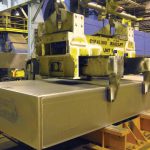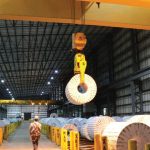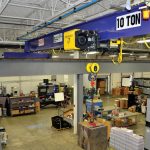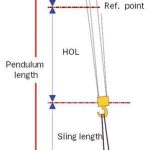Accomplished hoist operators can move a load without causing it to sway. But it is a skill acquired only with training and experience. Julian Champkin finds that anti-sway systems do even more than the name suggests.
Almost all manufacturing plants use cranes or overhead lifting apparatus. The safety of that equipment, and its efficiency and productivity, is largely down to the person who operates it. An experienced and skilled operator will work more efficiently, and have fewer accidents, than a novice.
That might seem a statement of the obvious. Yet in practice, in very many factories and facilities, untrained and novice members of staff often use hoists and perform many of the lifting operations. That might be because a pendant-controlled hoist seems an easy machine to use: press the up button on the dangling remote, and the hook goes up; press ‘along’ and it moves along.
That appearance is deceptive. Not very much thought, and not very much experience, will show that any load will sway when it is moved, and sometimes that sway may be dangerous. In any case, controlling it is not always easy or obvious. It takes skill. Which is why anti-sway systems have been growing in popularity. Many manufacturers now offer them; their use is not yet the norm rather than the exception, but as prices come down and automation becomes cheaper, they may be set to become so. “Ten years ago, crane anti-sway was seldomly a serious consideration for most end users,” says Dr. Khalid Sorensen, Chief Technical Officer for PaR Systems, whose ExpertOperator anti-sway system is at the cutting edge. “Now, however, people in our industry are more acutely aware of the hazards posed by load swing, and the great safety benefits of adding anti-sway.”
Thus Demag, SWF Krantechnik, Konecranes and Smart-crane all have offerings in the sector (see Hoist, June 2018). ABUS have their Abucontrol system, which can even be used for tandem lifts, as demonstrated at a steel fabrication plant in north-eastern Spain.
Their principles of operation vary, but almost all anti-sway systems depend on data, about the height, speed and position of the load and trolley, measured directly or indirectly by sensors and fed into software that in turn adjusts the movements of the trolley. One essential of anti-sway is that the movements of the overhead trolleys need to be very precisely controlled in order to cancel out the swaying of the load. In practice this means that frequency inverters on the trolley drives are a requirement; but these are becoming evermore the standard these days.
Aside from load sways being inherently dangerous—a heavy load swinging at the end of a rope in a busy factory is not a good idea— it is inefficient: a load cannot be set down until it has stopped swaying, and if you are waiting for natural air-damping to achieve this you may be waiting for some time. The heavier the load, the longer it will take.
R&M’s ControlMaster anti-sway system is an optional feature for the company’s QX modular crane package. The company recommends it for applications that require handling of delicate or critical loads. Examples they suggest include glass products, satellites, or aerospace equipment; but it is equally appropriate for heavy and robust loads, whose swinging takes up time, and whose impact in the event of a collision could cause damage and injury.
Their system works by registering the speed command that is entered at the controller. It brings the trolley to that desired speed, but does so with accelerations that keep the trolley at all times over the load. This prevents sway from developing. It uses a mathematical calculation to estimate the load swing. The calculation is based on the distance between the centre of the rope drum and the load—in other words, the pendulum length. As Galileo discovered in the 15th century, a long pendulum swings slowly, a shorter one swings fast.
Additional features such as an anti-sway indicator light, encoder-type height sensor, and radio controller with a sling length selector switch provide additional precision and safety.
Calibration of the system, they say, is quick and easy and is carried out on-site by an R&M factory representative.
One feature all such systems share is the easing of the crane operator’s burden. “Crane operators actually have a lot of things on which they must simultaneously concentrate,” says Sorensen. ‘They have to manipulate the load to a desired location, but they have to do it while controlling load swing, avoiding collisions with both fixed and moving obstacles, walking with the load through the workspace, communicating with co-workers, and all the while they must be correctly actuating the pendant or radio buttons.” That is why operators receive training, and why a practised, experienced operator should be worth their weight in gold. Sorensen has designed PaR’s ExpertOperator anti-sway system, which addresses precisely those issues, and has authored numerous papers on the subject.
Yet despite the complex demands of hoist operation in a busy and crowded work environment, an academic study of crane work practices by R. Geddes found, in author’s words, that “virtually everyone on the production floor will at one time or another operate the crane.” That study took place in 2009; but it is unlikely that the situation will have changed radically since then.
The results are unfortunate. Studies show that the vast majority of collisions are due to operator error. In one factory studied the proportion was 88 out of 101 incidents. The crane operations in that case study involved moving metal coils to and from cooling racks; the collision incidents therefore were not trivial. The costs associated with them were very large, and included costs of scrapping or reworking coils, crane repair, rack repair, lost production—and also operator injuries.
In 248 crane incidents reported to OSHA between 1997 and 2007, it was estimated that 70% of them might have been avoided had the crane personnel been operated in accordance with proper procedure and practice. “It is worth emphasising that this study only examined incidents in which an OSHA report was generated,” says Sorensen. “These represent only a small fraction of all global crane incidents, which may easily number in the thousands.”
Accomplished hoist operators can move a load without causing it to sway




没有评论:
发表评论